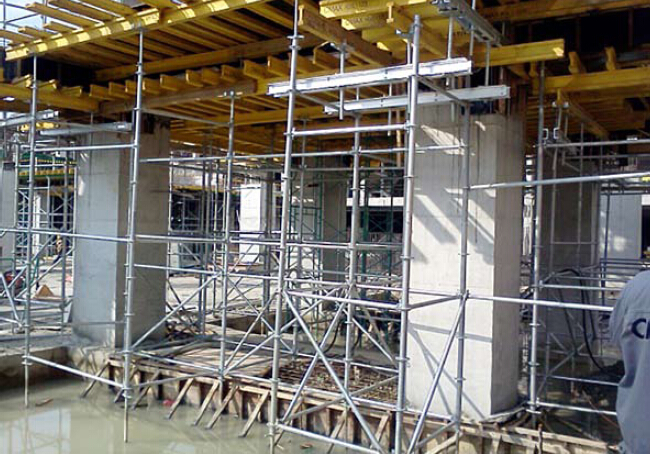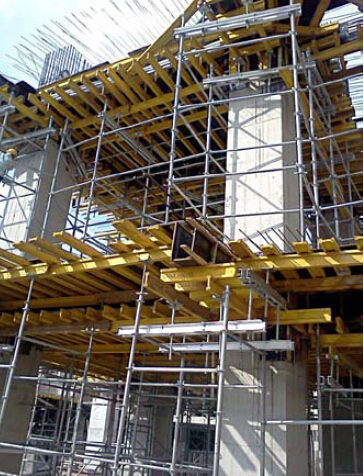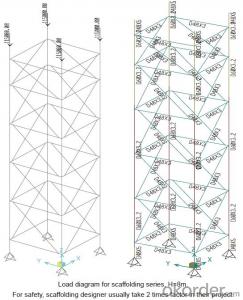Ring-lock scaffolding Accessories for formwork and scaffolding system
- Loading Port:
- Tianjin
- Payment Terms:
- TT OR LC
- Min Order Qty:
- 50 m²
- Supply Capability:
- 1000 m²/month
OKorder Service Pledge
Quality Product, Order Online Tracking, Timely Delivery
OKorder Financial Service
Credit Rating, Credit Services, Credit Purchasing
You Might Also Like
Ring-lock Scaffolding
A support system for construction, ownsadvantages of both cup-lock scaffolding andshoring tower.
It is in the development direction of new typescaffolding.
It is widely used in buildings, bridges, tunnels etc..
Characteristics:
◆ Easy to storage and transportation
◆ High degree of standardization
◆ Easy and quick erection
◆ Excellent stability and bearing capacity


- Q:How does steel formwork contribute to the sustainability of a construction project?
- Steel formwork contributes to the sustainability of a construction project in several ways. Firstly, steel formwork is highly durable and has a long lifespan. This means that it can be used for multiple construction projects, reducing the need for new formwork and minimizing waste. Additionally, the durability of steel formwork reduces the need for frequent repairs or replacements, saving both time and resources. Secondly, steel formwork is a reusable material. It can be easily disassembled and reassembled for use in different projects, reducing the demand for new formwork and minimizing the amount of waste generated. This significantly reduces the environmental impact of construction projects, as it reduces the need for new materials and decreases the amount of waste sent to landfills. Furthermore, steel formwork is highly efficient and allows for faster construction times. Its strength and stability enable the construction process to progress more quickly, reducing the overall duration of the project. This not only saves time but also reduces the energy consumption associated with construction activities, contributing to the overall sustainability of the project. Moreover, steel formwork is a recyclable material. At the end of its lifespan, the steel formwork can be recycled, further reducing its environmental impact. Recycling steel requires less energy and resources compared to manufacturing new steel, thus reducing greenhouse gas emissions and conserving natural resources. In summary, steel formwork contributes to the sustainability of a construction project by being durable, reusable, efficient, and recyclable. It reduces the need for new formwork, minimizes waste generation, saves construction time, and conserves resources. By incorporating steel formwork into construction projects, builders can significantly reduce the environmental impact while ensuring long-term durability and efficiency.
- Q:Can steel formwork be used for architectural concrete columns?
- Yes, steel formwork can be used for architectural concrete columns. Steel formwork is known for its strength and durability, making it a suitable choice for constructing concrete columns. It provides a rigid structure that can withstand the pressure exerted by the wet concrete during pouring and curing. Steel formwork also allows for precise shaping and detailing, enabling architects to create intricate designs and textures on the surface of the concrete columns. Additionally, steel formwork can be reused multiple times, making it a cost-effective option for projects that require multiple concrete columns. However, it is important to ensure that the steel formwork is properly coated or treated to prevent corrosion and ensure its longevity.
- Q:How does steel formwork affect the overall aesthetics of the structure?
- Steel formwork can have a significant impact on the overall aesthetics of a structure. Its sleek and smooth surface finish provides a clean and modern look, which is highly desired in contemporary architectural designs. The precision and accuracy of steel formwork also allows for intricate detailing and complex shapes to be achieved, enhancing the visual appeal of the structure. Furthermore, steel formwork enables the creation of sharp edges and crisp lines, resulting in a more refined and sophisticated appearance. This is particularly beneficial for structures with exposed concrete surfaces, as the use of steel formwork eliminates the need for additional surface treatments or finishing materials. Moreover, steel formwork offers versatility in terms of creating different textures and patterns on the concrete surface. By utilizing various surface treatments or coatings, such as acid etching or powder coating, architects and designers can further enhance the visual impact of the structure and create unique aesthetic effects. Additionally, steel formwork is known for its durability and structural integrity, ensuring that the aesthetics of the structure remains intact over time. Unlike other types of formwork, steel formwork does not warp or deform, providing a consistent and uniform appearance throughout the construction process and beyond. In summary, steel formwork positively influences the overall aesthetics of a structure by providing a sleek and modern finish, enabling intricate detailing and complex shapes, creating sharp edges and crisp lines, offering versatility in texture and pattern, and ensuring long-lasting durability.
- Q:Are there any regulations or standards that govern the use of steel formwork?
- Yes, there are regulations and standards that govern the use of steel formwork in construction. These regulations ensure the safety, quality, and performance of steel formwork systems. Some widely recognized standards include the American Concrete Institute (ACI) 347-04 and the Occupational Safety and Health Administration (OSHA) regulations. These standards provide guidance on design, installation, inspection, and maintenance of steel formwork to ensure its proper and safe use in construction projects.
- Q:Can steel formwork be used for curved or complex structures?
- Indeed, curved or intricate structures can be constructed using steel formwork. The employment of steel formwork provides abundant flexibility and adaptability, rendering it well-suited for fashioning diverse shapes and designs. Its robustness and sturdiness enable it to maintain its form, even when employed in curvilinear or intricate structures. Moreover, steel formwork can be conveniently fabricated and modified to meet particular project specifications, rendering it a perfect selection for erecting complex designs.
- Q:What are the different types of accessories used with steel formwork?
- Steel formwork is commonly enhanced with various accessories to improve its functionality and effectiveness in construction projects. Some examples of these accessories are: 1. Formwork Wedges: These small wedges, made of steel or plastic, secure the formwork panels together. They preserve accurate alignment and stability of the formwork system when concrete is poured. 2. Formwork Clamps: Designed to hold the formwork panels in place, clamps prevent any movement or displacement during concrete pouring and curing. They are typically steel and come in different sizes and designs to accommodate various formwork needs. 3. Formwork Ties: Ties connect the formwork panels and provide structural stability to the system. Available in steel or plastic and in different lengths and types (such as snap ties, wedge ties, and loop ties), they reinforce the formwork. 4. Formwork Braces: Steel braces reinforce and strengthen the formwork system. They support the panels, preventing bending or deformation during concrete pouring. 5. Formwork Hangers: These adjustable steel hangers suspend the formwork panels at the desired height, providing support. They can accommodate different formwork heights and configurations. 6. Formwork Spacers: Spacers maintain uniform spacing between formwork panels, ensuring consistent thickness in concrete walls or slabs. They are available in various sizes and shapes, made of plastic or steel. 7. Formwork Release Agents: These agents prevent concrete from adhering to the formwork surface. Before pouring concrete, they are applied to the panels, allowing for easy removal once the concrete has cured. Overall, these accessories are vital for maintaining the stability, alignment, and functionality of steel formwork systems. They contribute to the efficiency and quality of construction projects by providing reliable support and reinforcement during concrete pouring.
- Q:What are the considerations when designing steel formwork for foundations?
- When designing steel formwork for foundations, there are several key considerations that need to be taken into account. Firstly, the formwork needs to be strong and durable enough to withstand the weight and pressure of the wet concrete being poured into it. This requires selecting the appropriate grade and thickness of steel to ensure structural integrity. Secondly, the formwork should be designed to be easily assembled and disassembled, as well as adjustable to accommodate different foundation shapes and sizes. This can help save time and effort during the construction process. Additionally, the formwork should be designed with proper reinforcement and bracing to prevent any potential deformation or collapse under the weight of the wet concrete. This ensures the safety of workers and the stability of the foundation. Furthermore, considering the ease of formwork removal is essential. The design should facilitate the easy removal of the formwork after the concrete has cured, without causing any damage to the foundation or leaving any unwanted marks. Lastly, the cost-effectiveness of the formwork design should be considered. This includes evaluating the cost of materials, labor, and maintenance, as well as the potential for reuse or recycling of the formwork components. Overall, designing steel formwork for foundations requires careful consideration of factors such as strength, durability, assembly/disassembly, reinforcement, bracing, ease of removal, and cost-effectiveness.
- Q:How does steel formwork impact the overall sustainability of a project?
- Steel formwork can have a significant impact on the overall sustainability of a project. Firstly, steel is a highly durable material that can withstand repeated use, which means that steel formwork can be reused multiple times before reaching the end of its life cycle. This reusability reduces the need for frequent replacements, minimizing the consumption of materials and the waste generated during construction. Additionally, steel formwork is known for its strength and structural stability, allowing for the construction of robust and long-lasting structures. This means that buildings constructed with steel formwork are more likely to have a longer lifespan, reducing the need for frequent renovations or demolitions. Consequently, this leads to a decrease in the consumption of resources and the associated carbon emissions that come with new construction. Moreover, steel is a highly recyclable material, and steel formwork can be easily recycled at the end of its life cycle. The recycling process of steel requires less energy compared to the production of new steel, thereby reducing the carbon footprint of a project. By choosing steel formwork, construction projects can contribute to the circular economy by promoting the use of recycled materials and reducing landfill waste. Furthermore, steel formwork offers enhanced efficiency in construction processes. Its modular nature and ease of assembly make it a time-saving option, reducing construction time and, consequently, the energy consumption required for on-site operations. The accelerated construction process also minimizes disruption to the surrounding environment, reducing the overall environmental impact of the project. Lastly, steel formwork can contribute to the overall sustainability of a project by providing a safer working environment for construction workers. Its strength and stability ensure that the formwork remains secure during concrete pouring, minimizing the risk of accidents and injuries. This promotes the well-being of workers and aligns with the principles of social sustainability. In conclusion, steel formwork positively impacts the overall sustainability of a project by minimizing material consumption, reducing waste generation, promoting recycling, enhancing construction efficiency, and providing a safer working environment. Its durability, reusability, and recyclability contribute to the conservation of resources, reduction of carbon emissions, and long-term viability of structures. By opting for steel formwork, construction projects can advance sustainability goals and contribute to a more environmentally and socially responsible built environment.
- Q:Can steel formwork be used for projects with high groundwater levels?
- Yes, steel formwork can be used for projects with high groundwater levels. Steel formwork is known for its durability and resistance to water, making it suitable for construction projects in areas with high groundwater levels. Its robustness and waterproof properties allow it to withstand the pressure and moisture from the groundwater, ensuring the stability and integrity of the structure being built.
- Q:Can steel formwork be used for both slab and beam construction?
- Yes, steel formwork can be used for both slab and beam construction. Steel formwork is versatile and can be easily adjusted and customized to suit various shapes and sizes of slabs and beams. Its strength and durability make it suitable for handling the heavy loads and pressures involved in both slab and beam construction.
1. Manufacturer Overview |
|
|---|---|
| Location | |
| Year Established | |
| Annual Output Value | |
| Main Markets | |
| Company Certifications | |
2. Manufacturer Certificates |
|
|---|---|
| a) Certification Name | |
| Range | |
| Reference | |
| Validity Period | |
3. Manufacturer Capability |
|
|---|---|
| a)Trade Capacity | |
| Nearest Port | |
| Export Percentage | |
| No.of Employees in Trade Department | |
| Language Spoken: | |
| b)Factory Information | |
| Factory Size: | |
| No. of Production Lines | |
| Contract Manufacturing | |
| Product Price Range | |
Send your message to us
Ring-lock scaffolding Accessories for formwork and scaffolding system
- Loading Port:
- Tianjin
- Payment Terms:
- TT OR LC
- Min Order Qty:
- 50 m²
- Supply Capability:
- 1000 m²/month
OKorder Service Pledge
Quality Product, Order Online Tracking, Timely Delivery
OKorder Financial Service
Credit Rating, Credit Services, Credit Purchasing
Similar products
New products
Hot products
Hot Searches
Related keywords






















